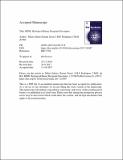Files in this item
BINK : Biological Binary Keypoint Descriptor
Item metadata
| dc.contributor.author | Saleiro, Mário | |
| dc.contributor.author | Terzić, Kasim | |
| dc.contributor.author | Rodrigues, J. M. F. | |
| dc.contributor.author | du Buf, J. M. H. | |
| dc.date.accessioned | 2018-10-12T23:48:39Z | |
| dc.date.available | 2018-10-12T23:48:39Z | |
| dc.date.issued | 2017-12 | |
| dc.identifier | 251375580 | |
| dc.identifier | 62a1ecc6-dcdd-44ee-b64d-358920ca9c62 | |
| dc.identifier | 85032458523 | |
| dc.identifier | 000418984100015 | |
| dc.identifier.citation | Saleiro , M , Terzić , K , Rodrigues , J M F & du Buf , J M H 2017 , ' BINK : Biological Binary Keypoint Descriptor ' , BioSystems , vol. 162 , pp. 147-156 . https://doi.org/10.1016/j.biosystems.2017.10.007 | en |
| dc.identifier.issn | 0303-2647 | |
| dc.identifier.other | RIS: urn:9C780C73DE5CB7F98410A7D6F88BD536 | |
| dc.identifier.uri | https://hdl.handle.net/10023/16212 | |
| dc.description | This work was supported by the EU under the FP-7 Grant ICT-2009.2.1-270247 NeuralDynamics, the Portuguese Foundation for Science and Technology (FCT), LARSyS [UID/EEA/50009/2013] and by FCT PhD grant to the 1st author SFRH/BD/71831/2010. | en |
| dc.description.abstract | Learning robust keypoint descriptors has become an active research area in the past decade. Matching local features is not only important for computational applications, but may also play an important role in early biological vision for disparity and motion processing. Although there were already some floating-point descriptors like SIFT and SURF that can yield high matching rates, the need for better and faster descriptors for real-time applications and embedded devices with low computational power led to the development of binary descriptors, which are usually much faster to compute and to match. Most of these descriptors are based on purely computational methods. The few descriptors that take some inspiration from biological systems are still lagging behind in terms of performance. In this paper, we propose a new biologically inspired binary keypoint descriptor: BINK. Built on responses of cortical V1 cells, it significantly outperforms the other biologically inspired descriptors. The new descriptor can be easily integrated with a V1-based keypoint detector that we previously developed for real-time applications. | |
| dc.format.extent | 676521 | |
| dc.language.iso | eng | |
| dc.relation.ispartof | BioSystems | en |
| dc.subject | Descriptor | en |
| dc.subject | Cortical cells | en |
| dc.subject | Keypoints | en |
| dc.subject | Applications | en |
| dc.subject | Bio-inspired | en |
| dc.subject | QA75 Electronic computers. Computer science | en |
| dc.subject | 3rd-DAS | en |
| dc.subject.lcc | QA75 | en |
| dc.title | BINK : Biological Binary Keypoint Descriptor | en |
| dc.type | Journal article | en |
| dc.contributor.institution | University of St Andrews. School of Computer Science | en |
| dc.identifier.doi | 10.1016/j.biosystems.2017.10.007 | |
| dc.description.status | Peer reviewed | en |
| dc.date.embargoedUntil | 2018-10-13 |
This item appears in the following Collection(s)
Items in the St Andrews Research Repository are protected by copyright, with all rights reserved, unless otherwise indicated.

